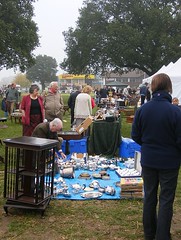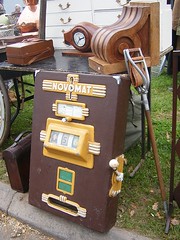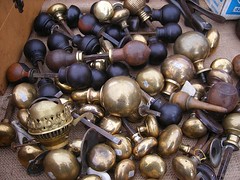 As an occasional viewer of the BBC TV programme "Bargain Hunt" I've often wondered what a big outdoor antiques fair is really like. In telly I see lots of stalls with stuff on. They seem to have furniture and odd things but it all looks like a posh car boot sale. Obviously I'm curious about this but not curious enough to shlep out to the edge of the home counties where all these things seem to take place. When I spotted a poster for an event at Stoneleigh, about 7 miles away that seemed like it would be worth a dabble.
As an occasional viewer of the BBC TV programme "Bargain Hunt" I've often wondered what a big outdoor antiques fair is really like. In telly I see lots of stalls with stuff on. They seem to have furniture and odd things but it all looks like a posh car boot sale. Obviously I'm curious about this but not curious enough to shlep out to the edge of the home counties where all these things seem to take place. When I spotted a poster for an event at Stoneleigh, about 7 miles away that seemed like it would be worth a dabble.Anyway, for the privilege of going in to look at the stalls the organisers relieve you of a fiver. If you are really keen, or just want first crack at the bargains, a tenner gets you in before 10am.
Once inside the event filled what are normally called "the cattle sheds", because that is what they are during the Royal Show. And they smell of cowpat in places. The display ring outside hosted tent based traders who normally had the larger items. I would guess at around 150 stalls but there could easily be more.
 Posh car boot sale would be a pretty reasonable description of the display. The quality of the goods on offer was much higher, as were the prices. Unlike a car boot though, every other stall isn't home to a coffee making machine. In fact the best thing about looking around was the variety of goodies on offer. To take a single example, one stall had a one arm bandit leaning against it and a 4 foot long Wherry hull inside.
Posh car boot sale would be a pretty reasonable description of the display. The quality of the goods on offer was much higher, as were the prices. Unlike a car boot though, every other stall isn't home to a coffee making machine. In fact the best thing about looking around was the variety of goodies on offer. To take a single example, one stall had a one arm bandit leaning against it and a 4 foot long Wherry hull inside.To me, the outside stalls were much more interesting than those inside. The later was the home of lots of pots and porcelain. I can't see the appeal of china figures, of which there were an awful lot, or those white china souvenir ware thingys. Both exist in huge quantities which makes me wonder why they cost so much. On the other hand there were also small pockets of unusual items, especially early plastic from an age when they were The Future and all sorts of wonderful designs appeared.
The crowds were unsurprisingly toward the upper age ranges - no OAP entrance ticket was offered for a good reason I suspect. How many of the items sold will re-appear on the market in a few years after an estate is split up ? They will doubtless find a whole new range of collectors who will snap them up along with modern collectibles.
Perhaps the best way to approach this event is to treat it as a design museum. If we ignore the tat made of the collectible market and often sold in the magazines that come with the weekend papers then there is a lot to appreciate. Art decco items stand beside Victorian ones and you can see the step change in design. The war years interrupted the evolution with austerity items picking up the clean lines but not the glamour. Later still colour made an appearance in a big way along with revolutionary materials. Much on sale will exhibit the highest standards of craftsmanship - if it didn't then the item didn't normally survive - but not all. Some things were built to last because they had to be. I bought a Model Laundry plywood box with metal edging. To me this is a useful box for my exhibition work, for the original owner it was solid because they wanted to reuse it time after time.
 I'm sure you could enjoy the fair without buying anything. I doubt there are many who are that parsimonious though. Obviously some collectors are looking for very specific items but most of us will just see something cheap and attractive and want to take it home. Hopefully this won't involve bankruptcy but I can see how that might happen ?
I'm sure you could enjoy the fair without buying anything. I doubt there are many who are that parsimonious though. Obviously some collectors are looking for very specific items but most of us will just see something cheap and attractive and want to take it home. Hopefully this won't involve bankruptcy but I can see how that might happen ?On Bargain Hunt, contestants have an hour to buy 3 items with the intention of selling them for a profit. I doubt I could do this and assume there is TV trickery at work. Just looking for fun took 4 hours allowing for a greasy burger break. To look properly takes either a lot longer or an expert eye. More expert than mine anyway.
Photos on Flickr



No comments:
Post a Comment